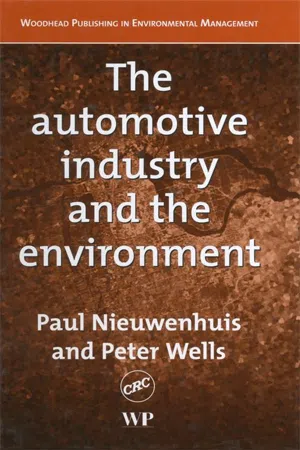
- 272 pages
- English
- ePUB (mobile friendly)
- Available on iOS & Android
The Automotive Industry and the Environment
About this book
The automotive industry currently faces huge challenges. The fundamental technological paradigm it relies on, volume production, has become progressively more unprofitable in the face of increasingly segmented niche markets. At the same time it faces increasing regulatory and social pressures to improve both the sustainability of its products and methods of production. Building on a wealth of research, The automotive industry and the environment addresses those challenges and how they can be met in producing a sustainable and profitable industry for the future.The authors first discuss the development of the automotive industry and the problems it currently faces. They then consider the solutions the industry can adopt. The book reviews trends in more environmentally-friendly technologies such as the use of more sustainable fuel sources and new types of modular design with built-in recyclability. However, these technologies can only be fully exploited if methods of manufacture change. The book also describes models of decentralised production, particularly the micro factory retailing (MFR) model, which provide an alternative to volume production and promise to be both more sustainable and more profitable.The automotive industry and the environment provides both a cogent diagnosis of the environmental and other problems facing the industry and a blueprint for a better future. It will be widely welcomed by the industry, policy makers and all those concerned with sustainable transport.- Addresses the challenges facing the automotive industry, from the increasing unprofitability of volume production to regulatory and social pressures to improve environmental and product sustainability- Examines how the automotive industry can meet the current challenges in producing a sustainable and profitable industry for the future- Reviews trends in more environmentally-friendly technologies such as the use of more sustainable fuel sources and new types of modular design with built-in recyclability
Frequently asked questions
- Essential is ideal for learners and professionals who enjoy exploring a wide range of subjects. Access the Essential Library with 800,000+ trusted titles and best-sellers across business, personal growth, and the humanities. Includes unlimited reading time and Standard Read Aloud voice.
- Complete: Perfect for advanced learners and researchers needing full, unrestricted access. Unlock 1.4M+ books across hundreds of subjects, including academic and specialized titles. The Complete Plan also includes advanced features like Premium Read Aloud and Research Assistant.
Please note we cannot support devices running on iOS 13 and Android 7 or earlier. Learn more about using the app.
Information
Introduction
1.1 Background
1.2 Change and complexity – can business really afford to keep things simple?
Table of contents
- Cover image
- Title page
- Table of Contents
- Copyright page
- Abbreviations and glossary
- 1: Introduction
- 2: The structure of the automotive industry
- 3: Markets and the demand for cars
- 4: From manufacturers to responsible mobility providers
- 5: Sector shift, inter-sector dynamics and futures studies
- 6: Powertrain and fuel
- 7: Fuel cells and the hydrogen economy
- 8: High volume car production: Budd and Ford
- 9: Alternatives to high volume car production
- 10: Sustainability
- 11: Sustainable mobility
- 12: Practical steps towards sustainability
- 13: Automobility 2050 – the vision
- 14: The distributed economy
- 15: The shape of the future
- 16: The roadmap
- 17: Micro factory retailing
- 18: Conclusions and implications
- Index